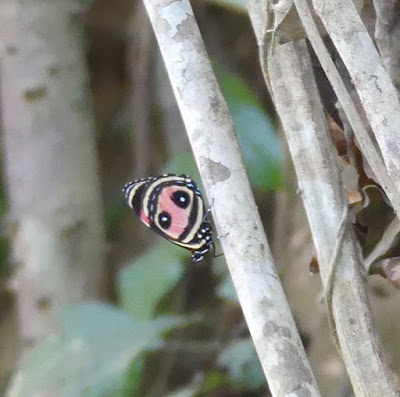Panama was in its dry season during our visit. Apparently, there are many more butterflies during the wet season. I thought we saw a lot of butterflies despite it being the dry season. I'm showing here only those for which I was able to get decent photographs.
Gray Cracker (Hamadryas februa)
From the Reiman Gardens of Iowa State University website: "There are 20 different butterflies of the genus Hamadryas. These butterflies are commonly known as Crackers, due to the males of the species having the ability to produce a percussive sound similar to the crackling of bacon in a frying pan. This unusual skill is believed to be either for mating or warding off rivals. Hamadryas iaodamia, or the Starry Night butterfly, is unique to this genus because it is the only one of its kind that does not produce this universally identifying crackling sound."
Red Cracker (Hamadryas amphinome)
Yes, it's really blue, but the underside of its wings are red. Nevertheless, this is how one usually sees cracker butterflies - perched like this.
The genus Caligo includes some 20 species of butterflies that are known for their large eye spot. Additionally, many species fly primarily at night. Caligo means darkness.
Long-tailed Skipper (Urbanus procne)
Owl butterfly, Caligo sp.
Cautiously identified as Little Metalmark (Calephelis virginiensis)
Tropical Checkered Skipper (Pyrgus orcus)
One of the cattlehearts? Longwing?
Unidentified worn fritillary, seems very much like a Gulf Fritillary (Agraulis vanillae), but I am not banking on this ID.
Banded Peacock (Anartia fatima)
Above and below: Same butterfly - Hewitson's Longwing (Heliconius hewitsoni)
A migrating daytime moth - Urania sp.
One of the patch butterflies, genus Chlosyne; perhaps Bordered Patch.
Truly spectacular Orange Daggerwing (Marpesia petreus).
Many-banded Daggerwing (Marpesia chiron)
Again, spectacular, Glossy Daggerwing (Marpesia furcula) or Sunset Daggerwing.
Above and below: a particularly pretty unidentified woodland satyr.
Another owl butterfly
Dirce Beauty (Colobura dirce)
Veined White Skipper (Heliopetes arsalte)
Mating patch butterflies
Above: Zebra Longwing (Heliconius charitonia) in flight because I thought it would never land. Below: Moments later - landed zebra longwing.
There are no good photographic guides or on-line resources to help identify Central American butterflies including Panama's butterflies. The best photo blog I found was titled sail3oceans.





























No comments:
Post a Comment